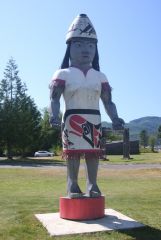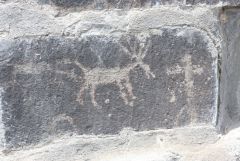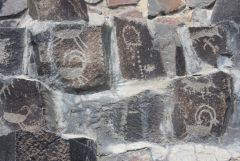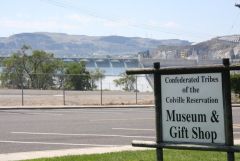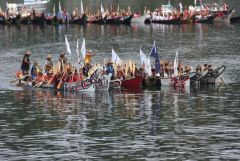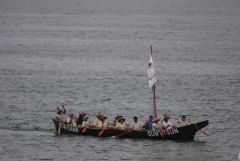-
Content Count
2713 -
Joined
-
Last visited
-
Days Won
44
Content Type
Profiles
Forums
Blogs
Gallery
Everything posted by tbutler
-
From the album: Native Tribes of the Pacific Northwest
Looking across the mouth of the Quillayute River to the Pacific Ocean. This is the site of the Quilieute tribal village of La Push. We enjoyed several days on the beaches near La Push and found the Quilieute Tribe to be quite open to visitors. We will return to this area again sometime in the future.© @Tom Butler
-
From the album: Native Tribes of the Pacific Northwest
This figure stands in front of the Makah Cultural and Research Center. The center houses many artifacts recovered from the village of Ozette which was buried under a mud slide. The mud slide preserved many of the artifacts until they were discovered and recovered by archaeologists in 1970. If visiting this area, this center is a must see collection of artifacts. Almost all of the items date back to before first contact with Europeans.© @Tom Butler
-
From the album: Native Tribes of the Pacific Northwest
Entrance sign at the Makah Cultural and Research Center. Among the items on display here are canoes, paddles, blankets, boxes made of cedar used for cooking, cooking utensils, games, toys, hats and artwork of the Makah Tribe. Inside the building is a full size reconstructed long house which you can explore. This is an amazing collection which gives insight into the lives of the Pacific Coastal Tribes. Like all native museums, photography was prohibited.© @Tom Butler
-
From the album: Native Tribes of the Pacific Northwest
While visiting Vancouver Island, friends took us to the west coast and the towns of Tofino and Ucluelet. This art gallery had wonderful examples of native art. Louise and I first saw the artwork of the Pacific Tribes on our trip to Alaska in 2006. We marveled at the totem poles and found the ancient and modern art of the region to be quite beautiful. The Provincial Museum in Victoria also has excellent examples.© @Tom Butler
-
From the album: Native Tribes of the Pacific Northwest
These are a few of the petroglyphs which were removed from the Wanapum village before the area was flooded by the Priest Rapids Dam. They are on display at Ginkgo State Park. The state park also hosts an extensive display of petrified wood which was collected from the area and brought to the state park during the days of the CCC in the 1930's. The site has the greatest variety of species of petrified trees in the world.© @Tom Butler
-
From the album: Native Tribes of the Pacific Northwest
A sampling of petroglyphs which were rescued from the Wanapum village before the area was flooded by Priest Rapids Dam. The visitors center at Wanapum Dam has reproductions of many of these but the originals are housed at the visitors center at Ginkgo State Park which is just north of I-90 where it crosses the Columbia River.© @Tom Butler
-
From the album: Native Tribes of the Pacific Northwest
The sign for the Colville Reservation Museum is within sight of Grand Coulee Dam. Photography was not permitted in the museum. There is a very nice collection of artifacts, photographs of tribal leaders and gatherings. The story of the Colville Tribe is well documented in the displays also. This served as our introduction to the culture of the Pacific Tribes.© @Tom Butler
-
From the album: Native Tribes of the Pacific Northwest
As the Paddle to Squaxin celebration began to close, groups of canoes were called to shore and welcomed by the host tribe, the Squaxin People. En-route they paddled individually, now they rafted their canoes together and brought them to shore. After asking permission to land, frequently in their native tongue, they were welcomed and came to greet their hosts on land.© @Tom Butler
-
From the album: Native Tribes of the Pacific Northwest
Another of the canoes which arrived. There were 94 individual canoes that arrived in Olympia, WA. Starting as much as a month before arrival, they had made their way from as far away as southern Alaska. When possible they would stop at native villages along the way and then be joined by canoes from those tribes.© @Tom Butler
-
From the album: Native Tribes of the Pacific Northwest
One of the beautifully decorated canoes which were brought to the Paddle to Squaxin event. After arriving here the members of the tribe would go to Squaxin Island for a council and potlatch which would last four days. Most all of the canoes would be transported home on trailers. These tribes which were once free to move up and down the coast now are constrained by international borders. This meeting offers a chance for relatives to get together to reinforce their ancient culture. Referring to themselves as brothers or cousins, these people all share common customs, art and similar languages. In ancient times the tribes warred at times and traded goods at other times. Now as their culture is fading away, they depend on meetings like these to build their common knowledge of the old ways.© @Tom Butler
-
From the album: Native Tribes of the Pacific Northwest
These are the people of the Pacific Northwest Tribes. While many are dressed in modern casual wear you can also see some traditional clothing including the pointed hats woven from cedar strips. The weaving is so tight that the hats are watertight. Talking with some of the people about their hats they told of the extensive work that is required to make one. They prize them highly for their practical as well as artistic style.© @Tom Butler
-
Welcome to all the new full timers. Great to see others explore the advantages of living in a motor home. Two years ago we decided to put a mobile home in the park where we winter each year so that is now our fixed home. Each spring we hit the road and live like a full timer for the summer then return south to enjoy the winter in our mobile home. Our motor home is parked in the driveway so it is never out of our minds. When the temperatures start to rise in the spring we're back on the road again. Even though we have a house now, the motor home still feels like home when we are on the road. We really love the life on wheels. After a while you will feel sorry for your friends who have a fixed home! Be sure to drop by to visit them from time to time! One thought to add to the conversation. We don't think of ourselves as camping, wherever we go, we are living there. Unlike the days of camping, now we have a more relaxed attitude about our travels. We sometime will spend several days in the motor home just catching up on laundry, sending messages to our children and friends, relaxing and enjoying just being at home. Other times we'll be out exploring new territory. When we don't feel like driving we'll make reservations for a week, several weeks or even a month if a place is really inviting. We have children and grandchildren to visit on our northern travels so we haven't made a habit of parking in one spot every summer as some people do. We have identified several places where we would love to spend summers every year. There is just too much great country out there to explore. Enjoy!
-
There aren't any really bad (gear jamming) mountain areas along this route. You will have some extended grades, certainly not northern Illinois flat. Just before you reach Seattle, you will pass through Snoqualmie Pass which is notorious for snow closures during the winter. There are also other areas with elevations high enough that there are gates for closing the highway during winter storms. Late October this shouldn't be a problem but as Bill has forecast, that may not be the case. Check your favorite weather program before you leave camp each morning. Determine what the overall picture is for weather along your travel for the day. If you have doubts, check the weather as you travel. If possible you can also tune in the Weather Channel during a rest or lunch stop to check on weather if you are really faced with some possible difficult weather. When it comes to winter travel, it is always better to be snowed in when you are in a campground, not along the road somewhere. A day or two of delay is always advised if bad weather is forecast. This can include high winds, heavy rain, fog or smoke. The end of September does hail the beginning of the wet season in the northwest US and you will likely see some rainy days and wet roads. Interesting places to stay, depending on how far off the road you want to go include Wall Drug, Badlands National Park in western South Dakota, Rapid City, SD and the Black Hills, Custer State Park, Mount Rushmore, and the Crazy Horse Memorial. You will also pass near the Little Bighorn National Battlefield in eastern Montana. These don't all have places to stay, check information on each attraction. Sometimes it is just nice to have a change of pace and get off the road for an hour, or a day or two. The badlands mentioned above are an excellent opportunity for this. The national park stretches for about 40 miles, paralleling I-90 about 10 miles south of the interstate. You can simply drive through (slowly) and if you want to stop there are numerous places to pull off the road to view the scenery or to stop for a short rest. Almost all the stops are RV friendly and that time of year you should have no problem getting in and out. At each end of the park it connects back to the interstate via a N/S road. There is some nice scenery along this route, give yourself some extra time so you don't have to rush through it. Have a nice trip.
-
A variation on this would be to have people donate their unwanted/unneeded RV and other items to the organization and then have an auction to benefit the organization. I was at a rally many years ago when the organization did this. Everyone enjoys an auction. I'm still using at least one item that I bought at that auction! You can get rid of your junque and help hold the dues down.
-
We have direct wired the toad lights to the motor home and never had a problem with the toad battery. Hook-up is simply a matter of plugging in the cord from the motor home to the receptacle on the bumper of the toad. Done! Can;t beat that for simple. We had the original installation done when we had the tow bar installed on the motor home and car. I modified it slightly after using it for a while. A friend we were in caravan with told us we would get brake lights or turn signals but when the brakes were on and we used the turn signals the brake light on that side wasn't lit. It was a simple matter to run another wire and hook up the turn signals separately. I could have asked the original installer to do that but figured it would be done that way without special request.
-

Encounters with Native American Cultures
tbutler posted a blog entry in Tom and Louise on Tour in North America
Seattle, the largest city in Washington, is named for an Indian chief. Many other features in this area have Native American names. On our travels, we visited several museums and cultural centers that helped to build our understanding of and respect for the culture. Our first museum was in Coulee Dam on the Colville Indian Reservation, in north-central Washington. The Colville Confederated Tribes Museum has a good historical record of the tribes with many old pictures, examples of clothing and accounts of the lives of their ancestors. Like all of the Indians in this part of the country, salmon played a key role in the lives of the Colville. Also like other tribes, its whole world changed when it began interacting with societies from other parts of the world. The Colville Indians lost their salmon when the Grand Coulee Dam was built in the 1930s. For the Colville, salmon were not just food; salmon also played a role in their stories and legends, which were the basis of their culture. Below Grand Coulee Dam is the Chief Joseph Dam, which is on the border of the Colville Indian Reservation. Chief Joseph was from the Nez Perce Tribe. He was a peacful man, making agreements with the U.S. Government to move his tribe to a reservation. When gold was discovered on the reservation, the government wanted to move Chief Joseph to a small part of the original reservation. Young Nez Perce warriors resisted and raided white settlements. This set off a chain of events that had the U.S. Cavalry pursuing the 700-member band for an extended time before Joseph's surrender. Chief Joseph surrendered expecting to be able to seek out members of the tribe, which had been lost in the extended fighting. Instead, he and the rest of his tribe were taken to Kansas and then Oklahoma, where they stayed until 1885. Many members of the tribe died in Oklahoma before they were allowed to return to the Pacific Northwest. They never were allowed to return to their homelands, ending up on what is now the Colville Reservation. Further down the Columbia River, the Wanapum and Chief Joseph Dams were built on the lands of the Wanapum Indian Tribe. Wanapum Dam visitors center hosts a Wanapum Heritage Center with a record of the history and culture of the Wanapum Indians. The Wanapum were moved from their homes so the Priest Rapids Dam could be built. Their historic homelands and homes were flooded by the lake backed up behind Priest Rapids Dam. One of the things said by Rex Buck Jr. at the dedication of Priest Rapids Dam, still haunts me. Rex Buck Jr. was awarded the Peace and Friendship Award by the Washington State Historical Society for his efforts to advance the cultural diversity of Washington State. He said to the crowd that day, "What we do to the Earth, the Earth will do to us." The Wanapum continue to follow some tribal traditions today, gathering roots and berries and fishing for salmon as permitted by Washington State law. They also operate an outreach program for schools and the community to bring them information about their culture. A while later we ventured onto the Olympic Peninsula. Louise wanted to start in Hoodsport and see the eastern side of the peninsula. After about three days touring, we learned of a celebration that would happen during the weekend. A gathering of the Pacific coastal tribes would begin with the Paddle to Squaxin. Traveling in their ceremonial and war canoes, the coastal tribes would come to Squaxin Island in the Olympic Peninsula. The Squaxiin tribe would host a meeting and potlatch on their home grounds. The canoes would arrive in the port at Olympia, Washington and the public was invited. We arrived shortly before noon and rode the shuttle to the port. A crowd of hundreds were there to welcome the canoes as they came into port. In the stands reserved for tribal members were drummers, chanting to welcome the arriving canoes. One by one and in groups of a dozen or more, canoes with three to 30 tribal members paddled their canoes into the port. Some wore ceremonial masks, others wore T-shirts. Most had painted ceremonial canoes and the native form of pointed paddles. Rowing in unison and periodically raising their paddles vertical above their heads in salute, they passed the crowd and then lined up along a roped area for their formal approach and request to land. I took many pictures of the first canoes, then learned that 94 canoes were expected. Even with my digital camera I had to re-evaluate the number of pictures I was taking. Besides my main 4GB card, I had an additional three 1GB cards. All but a few MBs remained at the end of the day. The procession of canoes was a spectacle to behold. Canoes from up the Canadian coast -- and another canoe was even flying an Alaskan flag -- came into port that day. We talked with some of the participants on the shuttle back to the parking lot. We let them know that how moved we were by the cultural display and that we appreciated being able to observe this pageant. We continued to the northern Olympic Peninsula. While visiting friends on Vancouver Island we visited an art gallery in Tofino. Later in an art shop in Duncan, we found several native art pieces, which we purchased for gifts. We also picked out a wall hanging for our home in Texas. Returning to the Olympic Peninsula, we continued to learn more about the tribes of the northern peninsula. Moving to the community of Forks on the northwestern side of Olympic National Park, we visited several tribal communities. The Makah reservation is located at Neah Bay and includes Cape Flattery, the northwestern tip of the Olympic Peninsula. To the south their original village, Ozette, was buried by mud flows. The tribe relocated to Neah Bay. Years later, beach erosion during a storm exposed the village in Ozette. Excavations of Ozette village has yielded many artifacts from pre-contact days. Those items, which provide a record of the civilization that existed before Europeans arrived around 1790, are housed in the Makah Cultural and Research Center in Neah Bay. Another native village is atLa Push on the Pacific shore west of Forks. In 1889, their homes were burned by a settler seeking to claim their territory for his own. All of their ancient masks and cultural records were lost in the fire. Today the Quileute tribe has a resort and RV park on the coast. With beaches of Olympic National Park to their north and south, the Quileute tribe has the land around the mouth of the Quillayute River. The Quileute tribe was the most welcoming of all the tribes we encountered. Each Wednesday night, the tribe has a drum circle and potlatch and the public is invited. Louise and I joined them one night. We were invited into the circle and were welcomed repeatedly. We watched, listened and were invited to join in their drum circle. The men with sacred wolf masks danced in the center of the circle as the ladies danced around the perimeter. The ceremony was very stylized, and by observing, we could detect behaviors of dancers that were part of the ritual dances. We left that evening feeling like we had a real connection with the Quileute people and their culture. Several days later we returned to find David Wilson, carving teacher at the Quileute school. Visiting with David and his wife, Anna, we saw some of his works of art. He has carved 20-foot-high totems and ceremonial staffs, canoe paddles and many other fine works of art. We discussed a small totem with him and came up with a design. He is currently working on carving that totem for us. Throughout our visit to the northwestern United States, we have encountered the Native American culture and have learned much from and about them. Uniformly they have welcomed us, sometimes personally, at other times through their celebrations, museums and cultural centers. Here are a people who have endured many injustices and have had their culture strongly altered in a relatively short period of time. Despite the forces that have thrust them into the modern era, they continue to be friendly and open to the outside world. Perhaps they remain too innocent in their approach to the outside world. I believe they are representing their culture to the rest of the world in the best possible way. To observe their customs and culture, one can not help but come away with admiration and respect for them and their struggle to cope with the changes thrust upon them. Since our travels into Canada years ago, Louise and I have used the term First Nations as a better descriptor for those who were here before the rest of us. After all, 350 million of us have moved in on their territory and proceeded to tell them where to live, how to live, what language to speak and what to believe. We owe them a great deal of respect. Perhaps we can even support them in their efforts to recover their native languages, customs and culture.- 2 comments
-
- Makah
- Native Americans
- (and 8 more)
-
Thanks tzimmermn, Your report on the solution to your problem helps everyone following this discussion to know what the problem was and how you solved it. Too often the originator of the discussion never returns with a report like yours. This makes the whole discussion much more valuable to everyone. I hope others will follow your example.
- 14 replies
-
- Chassis air reset
- Air bags
-
(and 1 more)
Tagged with:
-
We had a similar problem with our generator, also a 7.5 KW, this summer. We would get weird voltage and amperage readings and then it would shut down. It turned out to be a loose ground wire in the generator to coach connection. It had shorted and melted a bunch of stuff. We had Cummins/Onan replace the wiring harness from the generator to the link to the coach. Everything repaired, the generator works fine. The mechanic who found the problem said the set screw which should have been holding the ground wire in place was completely missing. It must have vibrated loose and fallen out which eventually happened also to the ground wire. If you want to check yours yourself, the cover for this box has a stern warning about high voltage, not to be ignored. Our was located on the front of the generator on the left side as you face the generator. You will see the wiring harness of the coach entering at the same location. Removing the cover will allow you to see the wiring. On ours the damage was apparent once the cover was removed.
-

Washer Will Not Complete Cycle
tbutler replied to peanutandskippy2's topic in Systems and Appliances
Peanut... When you measured the voltage at 116 was there a load on the current? While 116 is only slightly sub-standard, if that is a no-load or low load voltage then it likely is dropping when a large load is put on the line. I always check campground voltage when an air conditioner is running. If it stays steady, we have good electric. If it drops a little things might be marginal. If it drops a lot it means the wiring in the campground is inadequate. You have to test under load to determine this. A no/low load voltage tells you very little. When the washer is starting the spin cycle the motor draws a larger amperage than when the drum is spinning at full speed. The start up voltage will drop when the amperage draw increases. The same is true of air conditioners on start up. When the compressor begins to run it draws a higher amperage. Check the voltage under a high load situation. What is the voltage when one air conditioner is running? What is the voltage when two air conditioners are running? What happens to the voltage when the dryer starts its spin cycle with a load of wet clothes in the washer? You should see very little change in the voltage under these conditions if the campground wiring is good. If the voltage is dropping sharply, disconnect shore power and run the generator and try the above tests again. That would confirm an external problem. If you get the same result with the generator as the shore power, then the problem is likely within your coach. NashDrifter, I think you should have the generator checked, you have a problem in the generator or its connection to the coach power. -

Will Super WiFi Come On-line
tbutler replied to dickandlois's topic in RV Internet to Go/Staying in Touch
Doesn't sound practical to me. Two problems I see. With a range of 100 miles, the number of users on a single point could be enormous. The more users the slower the system, no matter how fast it functions. Second, this is a two way system, your computer or hot spot equipment has to broadcast back to some point. If that is 100 miles away I don't want it sitting on my lap. If the returns are picked up locally then why have just a single point 100 miles away? The TV system is in almost all cases a broadcast or one way system. The TV system is also a take-what-you-get system, they send out a signal and you can take it or leave it. A 100 mile range was practical and useful. The number of users didn't affect the speed or strength of the signal. But with a two way system the dynamics change. Now you have users requesting a wide variety of content and the system has to handle incoming requests, not just an outgoing signal. Perhaps this could be a satellite based system and be made workable, we already have internet satellite available. The problem is the uplink equipment cost about $5000 the last time I checked. That limits the number of users but also means most of us are happy to settle for a $100 hot spot. -
I have seen GE images of our rig in our winter campground several years ago and also more recently in the same campground parked next to our new mobile home. I also have seen GE pictures of our rig at my mother's home and our daughter's home. For some of these I have seen multiple images at different times. I also fly and have personally photographed our rig in a variety of locations. Of course my photos are more planned than the satellite photos. Just goes to show you better be on your best behavior, you never know who is watching.
-
There is an older discussion that deals with the many aspects of full timing and choosing an address. Full-timers' residency requirements has links to other discussions as well. I suggest that anyone in the process of establishing a new address study the possibilities carefully.
- 23 replies
-
I don't know if you have the Aladdin system, we have it in our 2004. Using the trip computer in the Aladdin, I can tell exactly how much fuel we have left. With the exception of fuel used by the generator, the Aladdin system will be within a gallon of what I can put in the tank. It is much more accurate than the analog fuel gauge on the dash. I use the Aladdin all the time to let me know exactly how much fuel I have left. I'm sure you will still want the analog gauge repaired but in the meantime if you have Aladdin, it can take care of tracking you mileage since you filled up, the amount of fuel used and fuel left.
-
It won't hurt to consult an electrician as Bill mentions. I believe you will find that if you run #4 wire to the garage you will have full strength 50A service at that point. Then using #6 wire for the final 25 feet to the motor home satisfies the requirement to keep the #6 wire under 100 feet. After all, the 50A service at a campground post has come a great distance, hopefully in #4 or better wire. You still use the #6 wire in your coach for the final 25 or 30 feet. It is true that you may never use the full 50A at any time but you never know. Also, when you sell your home, alternate wiring schemes will be caught by the inspection required in most locations. At that time you will have to correct the wiring in order to sell the house. You might was well have it done properly so you get to enjoy using the proper wiring rather than having to correct it only to sell the house. Besides, you'll sleep better at night. No worries!
-

Wiring And General Info On 2005 Challenger By Damon
tbutler replied to dbtoytrains's topic in Type A motorhomes
Wiring diagrams and user manual information may be available at a variety of surplus and salvage dealers. If you use the search box at the top right of this page and type in salvage you will come to a number of discussions from early in the web site history. There are many references in there for RV salvage companies that are found all over this country. Many specialize, some specialize in the owners manuals and documentation items. If you can't get the information you need from the manufacturer or a dealer then the salvage industry may be your best source of information and/or parts. Some of those links may be old. If you can't find a specific list post here to see if someone has a current reference.



